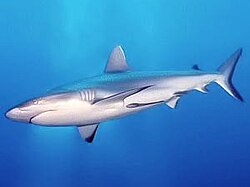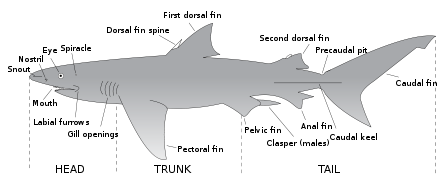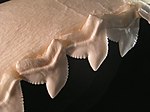Sharks (superorder Selachimorpha) are a type of fish with a full cartilaginous skeleton and a highly streamlined body. They respire with the use of five to seven gill slits. Sharks have a covering of dermal denticles that protect their skin from damage and parasites and improve fluid dynamics. They have several sets of replaceable teeth. Sharks range in size from the smalldwarf lanternshark, Etmopterus perryi, a deep sea species of only 17 centimetres (7 in) in length, to the whale shark, Rhincodon typus, the largest fish, which grows to a length of approximately 12 metres (39 ft) and which feeds only on plankton, squid, and small fish throughfilter feeding.
The bull shark, Carcharhinus leucas, is the best known of several species that swim in bothseawater and freshwater, as well as in deltas.
Physical characteristics
Skeleton
The skeleton of a shark is very different from that of bony fish and terrestrial vertebrates. Sharks and other cartilaginous fish (skates and rays) have skeletons made from cartilage, which is a flexible and dense connective tissue, but they are still considered bones. They function in the same way as human bones do. Like its relatives, rays and skates, the shark's jaw is not attached to the cranium. The jaw's surface, like its vertebrae and gill arches, is a skeletal element that needs extra support due to its heavier exposure to physical stress and its need for extra strength. It has therefore a layer of unique and tiny hexagonal plates called "tesserae", crystal blocks of calcium salts arranged as a mosaic. This gives these areas much of the same strength found in real and much heavier bony tissue.
Generally there is only one layer of tesserae in sharks, but the jaws of large specimens, such as the bull shark, tiger shark, and the great white shark, have been found to be covered with two to three layers or more, depending on the body size. The jaws of a large white shark may even have up to five layers.
In the rostrum (snout), the cartilage can be spongy and flexible to absorb the power of impacts.
The fin skeletons are elongated and supported with soft and unsegmented rays named ceratotrichia, filaments of elastic protein resembling the horny keratin in hair and feathers.
Respiration
Like other fish, sharks extract oxygen from seawater as it passes over their gills. Shark gill slits are not covered like other fish, but are in a row behind its head. A modified slit called a spiracle is located just behind the eye; the spiracle assists the water intake during respiration and even plays a major role in bottom dwelling sharks, but is also reduced or missing in active pelagic sharks. While moving, water passes through the mouth of the shark and over the gills — this process is known as "ram ventilation". While at rest, most sharks pump water over their gills to ensure a constant supply of oxygenated water. A small subset of shark species that spend their life constantly swimming, a behaviour common in pelagic sharks, have lost the ability to pump water through their gills. These species are obligate ram ventilators and would presumably asphyxiate if unable to stay in motion. (Obligate ram ventilation is also true of some pelagic bony fish species.)
The respiration and circulation process begins when deoxygenated blood travels to the shark's two-chambered heart. Here the blood is pumped to the shark's gills via the ventral aorta artery where it branches off into afferent brachial arteries. Reoxygenation takes place in the gills and the reoxygenated blood flows into the efferent brachial arteries, which come together to form the dorsal aorta. The blood flows from the dorsal aorta throughout the body. The deoxygenated blood from the body then flows through the posterior cardinal veins and enters the posterior cardinal sinuses. From there blood enters the ventricle of the heart and the cycle repeats.
Buoyancy
Unlike bony fish, sharks do not have gas-filled swim bladders for buoyancy. Instead, sharks rely on a large liver, filled with oil that containssqualene. The buoyant liver may constitute up to 30% of their body mass. Its effectiveness is limited, so sharks employ dynamic lift to maintain depth and sink when they stop swimming. Sandtiger sharks are also known to gulp air from the surface and store it in their stomachs, using the stomach as a swim bladder.
Because of this, most sharks need to constantly swim in order to breathe and cannot sleep very long, if at all, or they will sink. However certain shark species, like the nurse shark, have spiracles that force water across their gills allowing them to remain stationary at rest on the ocean bottom.
Some sharks, if inverted or stroked on the nose, enter a natural state of tonic immobility. Researchers have used this condition to handle sharks safely.
Osmoregulation
In contrast to bony fish, the blood and other tissue of sharks and Chondrichthyes in general is isotonic to their marine environments because of the high concentration of urea and trimethylamine N-oxide (TMAO), allowing them to be in osmotic balance with the seawater. This adaptation prevents most sharks from surviving in fresh water, and they are therefore confined to a marine environment. A few exceptions to this rule exist, such as the bull shark, which has developed a way to change its kidney function to excrete large amounts of urea. When a shark dies the urea is broken down to ammonia by bacteria — because of this, the dead body will gradually start to smell strongly of ammonia.
Teeth
The teeth of carnivorous sharks are not attached to the jaw, but embedded in the flesh, and in many species are constantly replaced throughout the shark's life; some sharks can lose 30,000 teeth in a lifetime. All sharks have multiple rows of teeth along the edges of their upper and lower jaws. They stick out of their mouth at angles of up to thirty degrees. New teeth grow continuously in a groove just inside the mouth and move forward from inside the mouth on a "conveyor belt" formed by the skin in which they are anchored. In some sharks rows of teeth are replaced every 8–10 days, while in other species they could last several months. The lower teeth are primarily used for holding prey, while the upper ones are used for cutting into it. The teeth range from thin, needle-like teeth for gripping fish to large, flat teeth adapted for crushing shellfish. Their teeth are used on necklaces.
Tails
Sharks have very distinctive tails .The tails (caudal fins) of sharks vary considerably between species and are adapted to the lifestyle of the shark. The tail provides thrust and so speed and acceleration are dependent on tail shape. Different tail shapes have evolved in sharks adapted for different environments. Sharks possess a heterocercal caudal fin in which the dorsal portion is usually noticeably larger than the ventral portion. This is due to the fact that the shark's vertebral column extends into that dorsal portion, allowing for a greater surface area for muscle attachment which would then be used for more efficientlocomotion among the negatively buoyant cartilaginous fishes. This is in contrast to the bony fishes, class osteichthyes, which possess a homocercal caudal fin.
The tiger shark's tail has a large upper lobe which delivers the maximum amount of power for slow cruising or sudden bursts of speed. The tiger shark has a varied diet, and because of this it must be able to twist and turn in the water easily when hunting, whereas theporbeagle, which hunts schooling fish such as mackerel and herring has a large lower lobe to provide greater speed to help it keep pace with its fast-swimming prey. It is also believed that sharks use the upper lobe of their tails to counter the lift generated by their pectoral fins.
Some tail adaptations have purposes other than providing thrust. The cookiecutter sharkhas a tail with broad lower and upper lobes of similar shape which are luminescent and may help to lure prey towards the shark. The thresherfeeds on fish and squid, which it is believed to herd, then stun with its powerful and elongated upper lobe.
Dermal denticles
Unlike bony fish, sharks have a complex dermal corset made of flexible collagenous fibers and arranged as a helical network surrounding their body. This works as an outer skeleton, providing attachment for their swimming muscles and thus saving energy. In the past, sharks' skin has been used as sandpaper.
Their dermal teeth give them hydrodynamic advantages as they reduce turbulence when swimming.
Body temperature
A few of the larger species, such as the shortfin mako, Isurus oxyrinchus, and the great white, are mildly homeothermic; that is: they are able to maintain their body temperature above the surrounding water temperature. This is possible because of the presence of the suprahepatic rate, a counter current exchange mechanism that reduces the loss of body heat. Muscular contraction also generates a mild amount of body heat. However, this differs significantly from true homeothermy, as found in mammals and birds, in which heat is generated, maintained, and regulated by metabolic activity.
Lifespan
The maximum lifespan of a shark varies from species to species. Most sharks live for 20 to 30 years, while the spiny dogfish lives a record lifespan of more than 100 years. Whale sharks (Rhincodon typus) have been hypothesized to also live over 100 years.
(wikipedia.org)




No comments:
Post a Comment